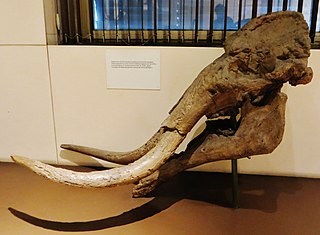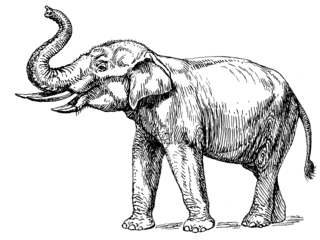 W
WAmebelodon is a genus of extinct proboscidean belonging to Amebelodontidae, a group of proboscideans related to the modern elephants and their close relative the mammoth. The most striking attribute of this animal is its lower tusks, which are narrow, elongated, and distinctly flattened with the degree of flattening varying among the different species. Two valid species are currently placed within this genus, which was endemic to North America. Other species once assigned to Amebelodon are now assigned to the genus Konobelodon, which was once a subgenus.
 W
WAnancus is an extinct genus of elephantoid proboscidean native to Afro-Eurasia, that lived from the Tortonian stage of the late Miocene until the genus' extinction during the early Pleistocene, roughly from 8.5–2 million years ago.
 W
WArchaeobelodon is an extinct genus of proboscidean of the family Amebelodontidae that lived in Europe and North Africa (Egypt) during the Miocene from 16.9—16.0 Ma, living for approximately 0.9 million years.
 W
WChoerolophodon is an extinct genus of proboscid which lived during the Miocene of Eurasia and Africa.
 W
WDeinotherium was a large prehistoric relative of modern-day elephants that appeared in the Middle Miocene and survived until the Early Pleistocene. During that time, it changed very little. In life, it probably resembled modern elephants, except it had downward-curving tusks attached to the lower jaw.
 W
WEubelodon is an extinct genus of gomphothere which lived in North America during the Miocene Epoch. It contains a single species: Eubelodon morrilli. Like other gomphotheres it had a superficially elephant-like appearance with a trunk and tusks.
 W
WGomphotheres are any members of the diverse, extinct taxonomic family Gomphotheriidae. Gomphotheres were elephant-like proboscideans, but not belonging to the family Elephantidae. They were widespread in across Afro-Eurasia and North America during the Miocene and Pliocene epochs and dispersed into South America during the Pleistocene following the Great American Interchange. Gomphotheriidae in its broadest sense is probably paraphyletic with respect to Elephantidae, which contains modern elephants. While most famous forms such as Gomphotherium had long lower jaws with tusks, which is the ancestral condition for the group, after these forms became extinct, the surviving gomphotheres had short jaws with either vestigal or no lower tusks (brevirostrine), looking very similar to modern elephants, an example of parallel evolution. During the Pleistocene epoch, most gomphotheres became extinct, with the last two genera, Cuvieronius persisting in southern North America and Notiomastodon having a wide range over most of South America until the end of the Pleistocene and human arrival in the Americas around 11,000 years ago.
 W
WGomphotherium is an extinct genus of proboscids from the Neogene and early Pleistocene of Eurasia, Africa, North America and possibly also Asia.
 W
WKonobelodon is a genus of amebelodont from southern Europe, China, and North America.
 W
WA mastodon is any proboscidean belonging to the extinct genus Mammut that inhabited North and Central America during the late Miocene or late Pliocene up to their extinction at the end of the Pleistocene 10,000 to 11,000 years ago. Mastodons lived in herds and were predominantly forest-dwelling animals. They survived on a mixed diet and obtained food by browsing and grazing, somewhat similar to modern elephants, but probably with greater emphasis on browsing
 W
WPlatybelodon was a genus of large herbivorous mammals related to the elephant. It lived during the middle Miocene Epoch in Africa, Asia and the Caucasus.
 W
WPrimelephas is a genus of Elephantinae that existed during the Miocene and Pliocene epochs. The name of the genus suggests 'first elephant'. These primitive elephantids are thought to be the common ancestor of Mammuthus, the mammoths, and the closely allied genera Elephas and Loxodonta, the Asian and African elephants, diverging some 4-6 million years ago. It had four tusks, which is unusual for an elephant. The type species, Primelephas gomphotheroides, was described by Vincent Maglio in 1970, with the specific epithet indicating the fossil specimens were gomphothere-like. Primelephas korotorensis is the only other species to be assigned to the genus.
 W
WProdeinotherium is an extinct representative of the family Deinotheriidae that lived in Africa, Europe, and Asia in the early and middle Miocene. Prodeinotherium, meaning "before terrible beast", was first named in 1930, but soon after, the only species in it, P. hungaricum, was reassigned to Deinotherium. During the 1970s, however, the two genera were once again separated, with Prodeinotherium diagnosed to include Deinotherium bavaricum, Deinotherium hobleyi, and Deinotherium pentapotamiae, which were separated based on geographic location. The three species are from Europe, Africa, and Asia, respectively. However, because of usage of few characters to separate them, only one species, P. bavaricum, or many more species, including P. cuvieri, P. orlovii, and P. sinense may be possible.
 W
WRhynchotherium is an extinct genus of proboscidea endemic to North America and Central America during the Miocene through Pliocene from 13.650—3.6 Ma, living for approximately 10 million years.
 W
WSerbelodon is an extinct genus of proboscidean. It had tusks and a trunk. It lived in North America during the Miocene Epoch, and it was closely related to Amebelodon. They had a diet that consisted of C3 plants which include fruits, tree cortex, herbs, and leaves.
 W
WSinomastodon is an extinct gomphothere genus, from the Late Miocene to the Early Pleistocene deposits of Asia. It is not to be confused with the genus Mammut from a different proboscidean family, whose members are commonly called "mastodons".
 W
WStegodibelodon is an extinct genus of elephant or gomphothere from the Miocene.
 W
WStegodon, meaning "roofed tooth" because of the distinctive ridges on the animal's molars, is a genus of the extinct subfamily Stegodontinae of the order Proboscidea. It was assigned to the family Elephantidae, but has also been placed in the Stegodontidae. Stegodonts were present from 11.6 million years ago (Mya) to the late Pleistocene, with unconfirmed records of localized survival until 4,100 years ago. Fossils are found in Asian and African strata dating from the late Miocene; during the Pleistocene, they lived across large parts of Asia and East and Central Africa, and in Wallacea as far east as Timor.
 W
WStegolophodon is an extinct genus of stegodontid proboscideans, with two tusks and a trunk. It lived during the Miocene and Pliocene epochs, and may have evolved into Stegodon. Fossils have been primarily found in Asia, but some have also been reported in Africa.
 W
WStegotetrabelodon is an extinct genus of primitive elephant with gomphothere-like anatomical features from the Late Miocene to Early Pliocene of Africa and Eurasia and the arabian peninsula. The type species is S. syrticus of late Miocene Africa, which reached roughly 4 m (13.1 ft) in shoulder height and 11–12 tonnes in weight. The other unequivocally recognized species is S. orbus, also of late Miocene Africa. Other species outside of Africa are questionably placed in this genus, including teeth from Late Miocene Hungary and Iran originally described as being of the Mastodon subgenus Bunolophodon, Chinese specimens originally described as being also of Mastodon, as well as of Tetralophodon and Stegodon, and a species from the late Miocene-aged Dokh Pathan Formation in Pakistan, S. maluvalensis.
 W
WTetralophodon is an extinct proboscidean genus belonging to the superfamily Elephantoidea.
 W
WZygolophodon is an extinct genus of African, Asian, and European mammutid that lived from the Miocene to the Late Pliocene.